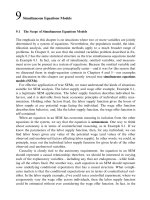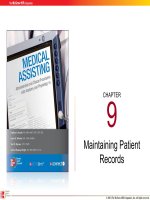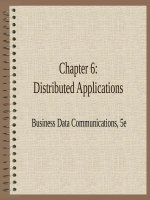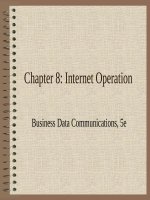Bussiness data communications 4e chapter 9
Bạn đang xem bản rút gọn của tài liệu. Xem và tải ngay bản đầy đủ của tài liệu tại đây (233.63 KB, 14 trang )
Chapter 9:
Data Link Control
Business Data Communications, 4e
Flow Control
✘ Necessary when data is being sent faster than
it can be processed by receiver
✘ Computer to printer is typical setting
✘ Can also be from computer to computer,
when a processing program is limited in
capacity
Stop-and-Wait Flow Control
✘ Simplest form
✘ Source may not send new frame until receiver
acknowledges the frame already sent
✘ Very inefficient, especially when a single
message is broken into separate frames, or when
the data link is long enough for significant delays
to be introduced
Sliding-Window Flow Control
✘ Allows multiple frames to be in transit
✘ Receiver sends acknowledgement with sequence number
of anticipated frame
✘ Sender maintains list of sequence numbers it can send,
receiver maintains list of sequence numbers it can receive
✘ ACK (acknowledgement) supplemented with RNR
(receiver not ready)
Error Control Process
✘ All transmission media have potential for
introduction of errors
✘ All data link layer protocols must provide method
for controlling errors
✘ Error control process has two components
✘ Error detection
✘ Error correction
Error Detection: Parity Bits
✘ Bit added to each character to make all bits
add up to an even number (even parity) or
odd number (odd parity)
✘ Good for detecting single-bit errors only
✘ High overhead (one extra bit per 7-bit
character=12.5%)
Error Detection: Cyclic
Redundancy Check (CRC)
✘ Data in frame treated as a single binary number,
divided by a unique prime binary, and remainder is
attached to frame
✘ 17-bit divisor leaves 16-bit remainder, 33-bit
divisor leaves 32-bit remainder
✘ For a CRC of length N, errors undetected are 2-N
✘ Overhead is low (1-3%)
Error Correction
✘ Two types of errors
✘ Lost frame
✘ Damaged frame
✘ Automatic Repeat reQuest (ARQ)
✘ Error detection
✘ Positive acknowledgment
✘ Retransmission after time-out
✘ Negative acknowledgment and retransmission
Stop-and-Wait ARQ
✘ One frame received and handled at a time
✘ If frame is damaged, receiver discards it and sends no
acknowledgment
✘ Sender uses timer to determine whether or not to retransmit
✘ Sender must keep a copy of transmitted frame until
acknowledgment is received
✘ If acknowledgment is damaged, sender will know it
because of numbering
Go-Back-N ARQ
✘ Uses sliding-window flow control
✘ When receiver detects error, it sends negative
acknowledgment (REJ)
✘ Sender must begin transmitting again from
rejected frame
✘ Transmitter must keep a copy of all transmitted
frames
Data Link Control
✘ Specified flow and error control for
synchronous communication
✘ Data link module arranges data into frames,
supplemented by control bits
✘ Receiver checks control bits, if data is intact,
it strips them
High-Level Data Link Control
✘ On transmitting side, HDLC receives data from
an application, and delivers it to the receiver on
the other side of the link
✘ On the receiving side, HDLC accepts the data and
delivers it to the higher level application layer
✘ Both modules exchange control information,
encoded into a frame
HDLC Frame Structure
✘ Flag: 01111110, at start and
end
✘ Address: secondary station
(for multidrop
configurations)
✘ Information: the data to be
transmitted
✘ Frame check sequence: 16or 32-bit CRC
✘ Control: purpose or function
of frame
✘ Information frames: contain
user data
✘ Supervisory frames:
flow/error control
(ACK/ARQ)
✘ Unnumbered frames: variety
of control functions (see
p.131)
HDLC Operation
✘ Initialization: S-frames specify mode and
sequence numbers, U-frames acknowledge
✘ Data Transfer: I-frames exchange user data, Sframes acknowledge and provide flow/error
control
✘ Disconnect: U-frames initiate and acknowledge









